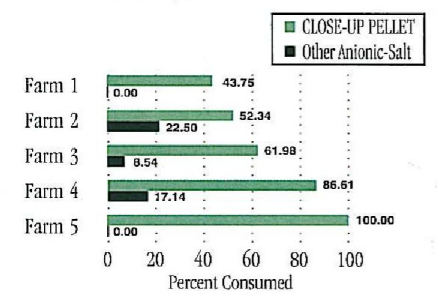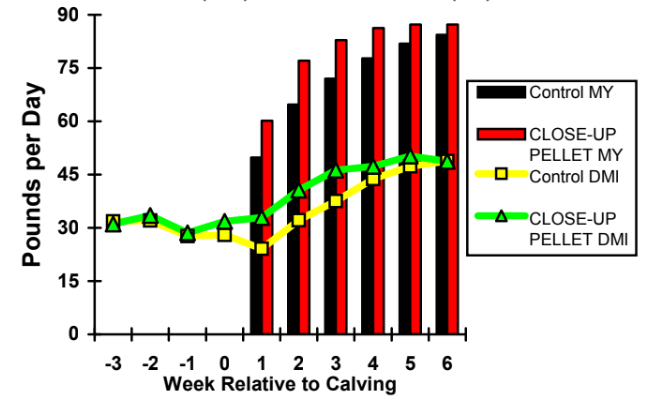Knowde Enhanced TDS
Identification & Functionality
- Animal Feed & Nutrition Functions
- Ingredients
- Calcium Chloride, Molasses, Natural Flavor, Vitamin B12, Vitamin E, Yeast, Calcium Carbonate, Calcium Sulfate, Vitamin D3, Zinc Oxide, Ammonium Sulfate, Ferrous Sulfate, Folic Acid, Magnesium Oxide, Niacin, Riboflavins, Thiamine Mononitrate, Zinc Sulfate, Biotin, Artificial Flavor, Copper Sulfate, BHT, Propionic Acid, Potassium Sulfate, Magnesium Sulfate, Calcium Iodate, Cobalt Carbonate, Manganese Sulfate, Sodium Selenite, Choline Chloride, Selenium Yeast, Vitamin A, Ammonium Chloride, Calcium Pantothenate, Distillers Dried Grains, Wheat Middlings, Ethoxyquin, Pyridoxine Hydrochloride, Ferrous Carbonate, Menadione Sodium Bisulfite, Manganous Oxide, Animal Fat
- Technologies
Features & Benefits
- Animal Feed & Nutrition Features
- Benefits
- Proven On The Farm
More than a dozen supervised field trials have been conducted at locations across the country proving CLOSE-UP PELLET really works where it counts- in the field.
- Less Milk Fever
On seven dairy farms, CLOSE-UP PELLET was fed to a total of 527 cows. The overall diagnosed rate of milk fever was 2.5%, less than half the US average of 6.0% (Technical Service Bulletins 292, 307, 308).
- Higher Serum Calcium
CLOSE-UP PELLET was fed to 49 cows on two dairy farms. The average serum Ca concentration at calving was 8.40 mg/dl, well above even the subclinical level ofhypocalcemia.
- Increased Milk Production
Dairymen, nutritionists and veterinarians report cows fed CLOSE-UP PELLET increased annual milk production by an average of 1792 lbs./cow.
- Less Retained Placenta
In one field trial, cows fed CLOSE-UP PELLET had an RP incidence rate of 2.7%, compared with 7.5% for cows fed a commercial supplement supplying chlorine as the sole source of anions. On another dairy farm, the RP incidence rate fell from 14.3% to 3.8%, once CLOSE-UP PELLET was fed.
- Better Palatability
On five different dairy farms, cows were fed a top-dress of either CLOSE-UP PELLET or a competitive anionic salt supplement. The cows fed CLOSE-UP PELLET consumed 79% of the product. Cows consumed only 9% of the competitive supplement.
Applications & Uses
- Markets
- Directions for Use
Feed 1.0 lb/cow/day, 14-21 days prior to calving, to supply 3000 mEq of anions per 22 lbs. dry matter in a Close-Up ration. During this period, also supply calcium at no less than 150 grams/cow/day.
- Mixing Instructions
Amount of Type B to add to total mixed ration* Amount of monensin in Type B, g/ton** Dry matter of total mixed ration, % Desired monensin concentration, 18.2 g/ton of total mixed ration***
400 55 50 lb 60 54.5 lb 65 59.1 lb - *Amount of Type B needed to produce the total mixed ration with desired level of monensin is as follows: (Desired level of monensin in total mixed ration g/ton) X (% dry matter of total mixed ration g/ton of monensin in type B) x 2000
- **It is recommended that Type B feeds containing more than 1440 g/ton must be further diluted before mixing in the mixed ration.
- ***100% dry matter basis.
Properties
Technical Details & Test Data
- Comparison of Close Up Pellet with Other Product
Milk production increases of at least 1500 lb per lactation are common in cows fed anionic salts (Beede, 1992; Oetzel, 1992):
Indian Trail Farms, a 350-cow Michigan dairy with a rolling herd average of 23,000 lb, compared performance of 46 cows fed CLOSE-UP PELLET with the year before, when another anionic salt product was fed:
CLOSE-UP PELLET OTHER PRODUCT
Peak milk lb 112.5 92.1 MLM-peak lb 88.64* 76.6* Milk fevers 2 4 Retained placentas 2 8 Displaced abomasums 1 3 *Peak milk adjusted using Management Level Milk
The 12 extra lb of MLM-peak milk indicates 2400 lb more milk/lactation.
- How do Anionic Salts Work
The cow needs nearly three times more calcium (Ca) after calving, as sudden milk production drains this mineral from her.
Normally parathyroid hormone (PTH)raises Ca levels in the blood. But the cow's response to PTH is compromised if blood pH has been increased by high dietary potassium (K) and sodium(Na) - positively - charged minerals known as “cations."
Unfortunately K is elevated in many forages, due to increased applications of fertilizer and manure. The problem is particularly common in dry-cow rations, which contain relatively more forages than are typical of lactation diets.
The "anions" chlorine (Cl) and sulfur (S) are fed to combat high cation levels. These negatively- charged minerals reduce blood pH, helping to overcome the effects of K and Na. PTH can then move more Ca from bone into blood.
The relationship between the strong cations (K and Na) and the strong anions (Cl and S) is expressed as Dietary Cation-Anion Difference ("DCAD"). For CLOSE-UP PELLET to be effective, DCAD should be a negative number.- The Close Up Pellet Feeding Program
During the last weeks before calving, nutrient demands dramatically increase while feed intake decreases by nearly 30%.
A high-quality concentrate must be fed at 12% to 1% of bodyweight during the 14 days before calving. Along with CLOSE-UP PELLET, this helps satisfy nutrient requirements
and also allows the cow to adjust to ingredients fed after calving.
One lb. of CLOSE-UP PELLET contains 3000 mEq of anions, plus complete vitamin/trace mineral supplementation. An effective close-up feeding program must also follow these simple rules:- Supply at least 120 gm of Ca per cow/day.
- Feed 40-60 gm of phosphorus per cow/day.
- Keep DCAD at less than 0 mEq.
- Maintain minimum 19% ADF.
- Keep Non-Fiber Carbohydrate under 40%.
- Test Results
- CLOSE-UP PELLETIncreased dry matter intake over 20% during the first 4 weeks after calving.
- It increased milk production more than 8 lbs./cow/day during the first 6 weeks.
- It with less milk fever, retained placenta, metritis, ketosis, and displaced abomasums.
- It Improved calcium and energy status, increasing serum ca and reducing serum nefa levels.
- CLOSE-UP PELLET Reduced urinepH from 8.29 to 6.78.
- Anionic Salts Work Fine, If The Cows Will Eat Them
Anionic salts help prevent milk fever and other fresh-cow diseases. But the problem is cows don't like the taste of anionic salts, even diluted in a TMR.
There is a one lb/day anionic-salt supplement that cows really will eat during the critical two weeks prior to calving. Dawe's Laboratories' CLOSE-UP PELLET is so palatable it earned a US patent. It's so palatable cows will eat it, even as a top-dress:
32 cows on 5 dairies were offered a top-dress both of CLOSE-UP PELLET and of a leading anionic-salt supplement, each at its recommended daily amount. Cows preferred CLOSE-UP PELLET by 9 to 1:
After a day or two, virtually all cows completely consume CLOSE-UP PELLET as a top-dress. And CLOSE-UP PELLET doesn't depress intake when mixed in concentrates and TMRs, as do other anionic-salt supplements.
- Test Results
Research conducted at the University of Missouri by Dr. Jim Spain shows cows fed CLOSE-UP PELLET as part of an effective close- up feeding program have greater feed intake and higher milk production, as well as improved health, calcium status, and energy balance. Net profit per cow increased substantially, because:

- CLOSE-UP PELLET Increased dry matter intake over 20% during the first 4 weeks after calving.
- It increased milk production more than 8 lbs./cow/day during the first 6 weeks.
- It with less milk fever, retained placenta, metritis, ketosis, and displaced abomasums.
- It Improved calcium and energy status, increasing serum ca and reducing serum nefa levels.
- CLOSE-UP PELLET Reduced urine pH from 8.29 to 6.78.
Packaging & Availability
- Packaging Type
- Packaging
50-lb bags.